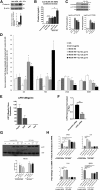Clusterin Impairs Hepatic Insulin Sensitivity and Adipocyte Clusterin Associates With Cardiometabolic Risk
- PMID: 30659075
- PMCID: PMC6385696
- DOI: 10.2337/dc18-0870
Clusterin Impairs Hepatic Insulin Sensitivity and Adipocyte Clusterin Associates With Cardiometabolic Risk
Abstract
Objective: Components of the adipose tissue (AT) extracellular matrix (ECM) are recently discovered contributors to obesity-related cardiometabolic disease. We identified increased adipocyte expression of ECM-related clusterin (apolipoprotein J) in obese versus lean women by microarray. Our objective was to determine 1) whether subcutaneous AT adipocyte (SAd) clusterin and serum clusterin are associated with insulin resistance (IR) and known markers of cardiometabolic risk and 2) how clusterin may contribute to increased risk.
Research design and methods: We validated increased clusterin expression in adipocytes from a separate group of 18 lean and 54 obese individuals. The relationship of clusterin gene expression and plasma clusterin with IR, cardiovascular biomarkers, and risk of cardiovascular disease (CVD) was then determined. Further investigations in human cultured cells and in aged LDLR-/- mice prone to development of obesity-associated complications were performed.
Results: SAd clusterin correlated with IR, multiple CVD biomarkers, and CVD risk, independent of traditional risk factors. Circulating human clusterin exhibited similar associations. In human adipocytes, palmitate enhanced clusterin secretion, and in human hepatocytes, clusterin attenuated insulin signaling and APOA1 expression and stimulated hepatic gluconeogenesis. LRP2 (megalin), a clusterin receptor, highly expressed in liver, mediated these effects, which were inhibited by LRP2 siRNA. In response to Western diet feeding, an increase in adipocyte clusterin expression was associated with a progressive increase in liver fat, steatohepatitis, and fibrosis in aged LDLR-/- mice.
Conclusions: Adipocyte-derived clusterin is a novel ECM-related protein linking cardiometabolic disease and obesity through its actions in the liver.
© 2019 by the American Diabetes Association.
Figures



Similar articles
-
Clusterin and Its Role in Insulin Resistance and the Cardiometabolic Syndrome.Front Immunol. 2021 Feb 25;12:612496. doi: 10.3389/fimmu.2021.612496. eCollection 2021. Front Immunol. 2021. PMID: 33717095 Free PMC article. Review.
-
Insulin-sensitizing effects of vitamin D repletion mediated by adipocyte vitamin D receptor: Studies in humans and mice.Mol Metab. 2020 Dec;42:101095. doi: 10.1016/j.molmet.2020.101095. Epub 2020 Oct 10. Mol Metab. 2020. PMID: 33045433 Free PMC article. Clinical Trial.
-
Adipose tissue depot-specific intracellular and extracellular cues contributing to insulin resistance in obese individuals.FASEB J. 2020 Jun;34(6):7520-7539. doi: 10.1096/fj.201902703R. Epub 2020 Apr 15. FASEB J. 2020. PMID: 32293066 Free PMC article.
-
Alterations of plasma metabolite profiles related to adipose tissue distribution and cardiometabolic risk.Am J Physiol Endocrinol Metab. 2015 Oct 15;309(8):E736-46. doi: 10.1152/ajpendo.00231.2015. Epub 2015 Aug 25. Am J Physiol Endocrinol Metab. 2015. PMID: 26306599
-
Adipocyte Fatty Acid-Binding Protein, Cardiovascular Diseases and Mortality.Front Immunol. 2021 Mar 19;12:589206. doi: 10.3389/fimmu.2021.589206. eCollection 2021. Front Immunol. 2021. PMID: 33815359 Free PMC article. Review.
Cited by
-
Sterol O-acyltransferase 2 chaperoned by apolipoprotein J facilitates hepatic lipid accumulation following viral and nutrient stresses.Commun Biol. 2021 May 12;4(1):564. doi: 10.1038/s42003-021-02093-2. Commun Biol. 2021. PMID: 33980978 Free PMC article.
-
Integrative analysis of multi-omics data to detect the underlying molecular mechanisms for obesity in vivo in humans.Hum Genomics. 2022 May 14;16(1):15. doi: 10.1186/s40246-022-00388-x. Hum Genomics. 2022. PMID: 35568907 Free PMC article.
-
Alterations of DNA methylation during adipogenesis differentiation of mesenchymal stem cells isolated from adipose tissue of patients with obesity is associated with type 2 diabetes.Adipocyte. 2021 Dec;10(1):493-504. doi: 10.1080/21623945.2021.1978157. Adipocyte. 2021. PMID: 34699309 Free PMC article.
-
Circulating IL-6, clusterin and irisin in obese subjects with different grades of obesity: association with insulin resistance and sexual dimorphism.Arch Endocrinol Metab. 2021 Nov 1;65(2):126-136. doi: 10.20945/2359-3997000000336. Epub 2021 Feb 24. Arch Endocrinol Metab. 2021. PMID: 33905632 Free PMC article.
-
Irisin and its relationship with metabolic health: more questions than answers.Arch Endocrinol Metab. 2021 Apr 5;65(2):121-123. doi: 10.20945/2359-3997000000355. Arch Endocrinol Metab. 2021. PMID: 33826837 Free PMC article. No abstract available.
References
-
- Isomaa B, Almgren P, Tuomi T, et al. . Cardiovascular morbidity and mortality associated with the metabolic syndrome. Diabetes Care 2001;24:683–689 - PubMed
-
- DeFronzo RA, Ferrannini E. Insulin resistance. A multifaceted syndrome responsible for NIDDM, obesity, hypertension, dyslipidemia, and atherosclerotic cardiovascular disease. Diabetes Care 1991;14:173–194 - PubMed
-
- Graßmann S, Wirsching J, Eichelmann F, Aleksandrova K. Association between peripheral adipokines and inflammation markers: a systematic review and meta-analysis. Obesity (Silver Spring) 2017;25:1776–1785 - PubMed
Publication types
MeSH terms
Substances
Grants and funding
LinkOut - more resources
Full Text Sources
Medical
Research Materials
Miscellaneous

